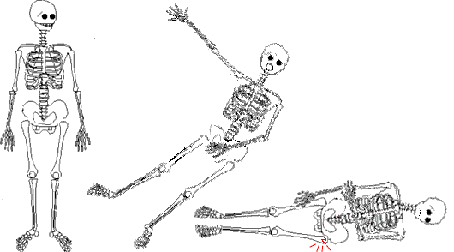
use of sedatives
previous fall
cognitive impairment
visual impairment
lower-extremity disability
foot problems
gait abnormalities

| The risk factors for falls include:
use of sedatives previous fall cognitive impairment visual impairment lower-extremity disability foot problems gait abnormalities |
At home, elderly or frail people should:
keep bathroom lights on
install grab bars
avoid loose rugs
remove clutter
keep wires behind furniture
Studies have shown that paying attention to these details significantly reduces the incidence of falling.
 | Click on the picture to see what's wrong here!This poster is from the Surgeon General's Report about osteoporosis. |
In addition, gait training or balance training, along with muscle strengthening, can help to prevent falls. People with slow gaits are more likely to fall on their greater trochanter, which increases the risk of a fracture by about 6 times compared to falls in other directions.
Thin women have less fat and soft tissue around the hips, and if they fall the full impact is transferred to the bone. Padding using materials that absorb the energy can significantly reduce the risk of hip fracture. These pads have been tested in a Danish nursing home, and after one year the rate of hip fractures was half in the group assigned to the pads. None of the patients had a hip fracture while they were wearing the pads.

These pads are available from (Safehip)
A larger study has shown that hip protectors prevent fractures. Kannus, P.(2000). Prevention of Hip Fracture in Elderly People with Use of a Hip Protector. N Engl J Med 343(21): 1506-1513. This study was community-based and involved 1801 frail elderly patients. Those assigned to the hip protector group had half as many fractures. Of 1034 falls, only 4 hip fractures occured while patients were wearing the protectors. The brand of the hip protector used in this study was KPH Hip Protector, from Helsinki, Finland.
Since then, several other studies have shown what seems to be obvious: these hip pads don't work unless the people wore them! Compliance is a problem with the hip protectors, especially in frail patients who are at the highest risk.

